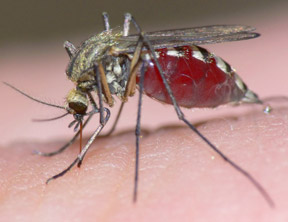A potential lifesaver
 You
may not have heard much about malaria recently, mainly due to the
increased focus on dengue in our part of the world. But malaria remains
a killer mainly in Asia and Africa - every year there are more than 200
million cases and about 660,000 deaths around the world - mostly of
babies and children under five. You
may not have heard much about malaria recently, mainly due to the
increased focus on dengue in our part of the world. But malaria remains
a killer mainly in Asia and Africa - every year there are more than 200
million cases and about 660,000 deaths around the world - mostly of
babies and children under five.
The six worst-affected countries are Nigeria, Democratic Republic of
the Congo, Tanzania, Uganda, Mozambique and Ivory Coast, which have 47
percent of the world's cases or around 103 million. India, with 24
million cases a year, has the highest malaria prevalence in South Asia.
Malaria is caused by the bite of a female Anopheles mosquito carrying
the malaria parasite, which makes its way through the blood stream to
the liver, where it grows and reproduces. The symptoms include fever,
headache, chills and vomiting and if not treated in time, can lead to
coma and death.
Small children and pregnant women are the biggest risk groups.
Led by the World Health Organisation, the entire world is fighting
the potentially lethal mosquito-borne disease with a vengeance. Sri
Lanka has one of the more successful programmes to fight and eradicate
malaria among the developing countries.
In the decade from 2000 to 2010, the malaria death toll was cut by 26
percent around the world (33 percent in Africa) and considerable time,
money and effort has been invested in an effort to eradicate it.
Nevertheless, the disease remains a huge threat to children's long-term
health and development in developing countries.
Progress
 While pharmaceutical companies have made considerable progress in
making malaria drugs, there is only one way to ensure that malaria does
not have a chance in the first place - a viable, affordable vaccine. While pharmaceutical companies have made considerable progress in
making malaria drugs, there is only one way to ensure that malaria does
not have a chance in the first place - a viable, affordable vaccine.
Promising results from a large-scale clinical trial mean that the
world's first malaria vaccine may be on the market in just two years and
could potentially save hundreds of thousands of lives a year.
The phase III clinical trial of more than 15,000 infants and young
children in Africa found that the vaccine - called RTS,S - continued to
protect the youngsters from malaria for up to 18 months after
vaccination. The ongoing trial of the RTS,S vaccine is being conducted
by 11 research centres in seven African countries, together with the
PATH Malaria Vaccine Initiative and drug maker GlaxoSmithKline.
During the 18-month follow-up and human trial period, there was a 46
percent reduction in the number of malaria cases in children aged five
months to 17 months at first vaccination, working out to 941 fewer cases
of malaria for every 1,000 children. Cases of severe malaria were
reduced by 36 percent and malaria hospitalisations were reduced by 42
percent.
This is a significant breakthrough in the fight against malaria.
Based on the data, vaccine maker GlaxoSmithKline plans to apply next
year to have the vaccine approved by the European Medicines Agency. If
the agency approves the vaccine, the World Health Organisation said it
could issue a recommendation for the vaccine as early as 2015.
However, the WHO should ensure that the vaccine is affordable in
large quantities to health authorities of developing countries and even
individual customers in those countries. Some vaccines and medications
available for critical diseases are very expensive at present, which
limits their widespread adoption. The administration of the vaccine can
be integrated to the immunisation schedules of most countries to make it
even easier for patients.
It is also likely to be a boon for international travellers who now
have to take a dose of preventive medication which do not always work.
Travelling to malaria-prone areas is always a risk but a proper vaccine
can cut down the rate of infection.
While there is hardly any doubt that a vaccine could be a “game
changer”, there are certain other steps that can be taken to minimise
all mosquito-borne diseases, not just malaria.
The UN/WHO already has a program mostly funded by the UK to supply
bed nets to underprivileged children in many developing countries.
The WHO says 150 million new nets are needed every year for new
families and to replace worn-out nets.
The other option is to destroy mosquito breeding places. Despite
repeated warnings by the authorities, many households, schools and even
government institutions continue to offer a refuge to mosquito larvae
which will increase the chances of more people contracting dengue,
malaria, filarial and other such diseases. More awareness campaigns
should be conducted in schools, workplaces and through the media to
stress the importance of destroying mosquito breeding grounds.
Vaccine
Apart from the promised vaccine, a new class of drugs has brought
high hopes of reducing the risk of catching malaria. Artemisinin
combination therapies, combining drugs made from the Artemisia plant -
originally grown and used in China - with older drugs have high
efficacy. These new drugs are essential because the malaria parasite has
become resistant to older drugs such as chloroquine and sulfadoxine
pyrimethamine in many regions. In 2011, 278 million courses of the
artemisinin combination drugs were bought for use in endemic countries,
though resistance to these drugs too is becoming a problem in some Asian
countries.
Attention will be focused on many of these issues including the
vaccine at the world malaria conference now under way in Durban, South
Africa. A major highlight of the conference, which is held every four
years at an African venue, will be the launch of the Pan African
Mosquito Control Association (PAMCA), formed to promote control of and
research on mosquitoes involved in disease transmission and to
disseminate valuable information on the study of mosquitoes across
Africa and worldwide.
A new advanced malaria testing tool will also be launched at the
Conference in Durban. Atomo Diagnostics, an Australian healthcare
company which recently launched the innovative all-in-one rapid HIV test
is set to introduce its malaria counterpart to the continent at the
conference. The device will allow for quick and reliable diagnosis of
malaria in Africa and change the way testing for the disease is
conducted in the continent. Atomo Rapid malaria, which is ideal for both
professional and self-test applications, will enable quick and reliable
diagnosis of malaria in the field. This will hopefully pave the way to
detect malaria cases very early so that appropriate treatment could be
given.
A combination of these steps will help control and eradicate malaria
in the long term and save millions of lives in Asia and Africa. |

